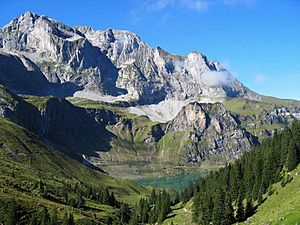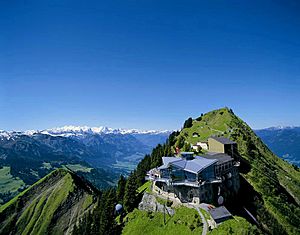Nidwalden facts for kids
Quick facts for kids
Canton of Nidwalden
Kanton Nidwalden (German)
Canton of Nidwald
|
|||||
|---|---|---|---|---|---|
|
|||||
| Capital | Stans | ||||
| Subdivisions | 11 municipalities | ||||
| Area | |||||
| • Total | 275.84 km2 (106.50 sq mi) | ||||
| Population
(December 2020)
|
|||||
| • Total | 43,520 | ||||
| • Density | 157.773/km2 (408.63/sq mi) | ||||
| GDP | |||||
| • Total | CHF 2.867 billion (2020) | ||||
| • Per capita | CHF 66,209 (2020) | ||||
| ISO 3166 code | CH-NW | ||||
| Highest point | 2,901 m (9,518 ft): Rotstöckli | ||||
| Lowest point | 434 m (1,424 ft): Lake Lucerne | ||||
| Joined | 1291 | ||||
| Languages | German | ||||
Nidwalden (also called Nidwald) is one of the 26 cantons that make up Switzerland. It has eleven towns and villages, and its capital city is Stans. Nidwalden is often called a "half-canton" because it shares some history with Obwalden, another half-canton.
Nidwalden is located in the middle of Switzerland. It shares borders with other cantons like Obwalden to the west and Lucerne to the north. The canton is mostly in the Alps, which are large mountains, and it's south of Lake Lucerne.
It is one of the smaller cantons in Switzerland. In 2007, about 40,287 people lived there. The biggest town is Stans, followed by Hergiswil and Buochs.
Long ago, Nidwalden and Obwalden were part of a larger area called Unterwalden. This area was one of the first three to join together to form the Old Swiss Confederacy in 1291. Over time, Unterwalden slowly divided into the two separate areas we know today as Obwalden and Nidwalden.
Contents
History of Nidwalden
Early Settlements and Roman Times
People have lived in Nidwalden for a very long time. The oldest signs of human life are from the Neolithic period (New Stone Age), around 4000 to 3100 BC. These signs were found near Stansstad. Later, during the Bronze Age (1400–1100 BC), more settlements appeared near Hergiswil and Ennetmoos.
A grave from the La Tène Culture (500–100 BC) was found in Stans. This shows that people have lived in the Nidwalden area for thousands of years.
During the time of the Roman Empire, the area was home to people with Gallo-Roman or Celtic backgrounds. Even though there are not many items left from them, many local names for towns, rivers, and mountains come from Celtic or Gallo-Roman words. Around the 8th century, a group called the Alemanni came into the valleys and mixed with the local people. A Roman Catholic church was built in Stans around this time.
Joining the Swiss Confederation
In the late 1200s, most of the land in Nidwalden was owned by a few powerful families and religious groups called abbeys. By 1291, the main owners were the Habsburgs, Murbach Abbey, and Engelberg Abbey.
In 1291, Rudolph of Habsburg bought Obwalden. Because of this, the people of Nidwalden decided to team up with Uri and Schwyz. This alliance is seen as the start of the Old Swiss Confederacy. Obwalden joined this group shortly after Nidwalden.
Developing Government and French Invasion
At first, there wasn't a formal government in Nidwalden. But by the late 1300s, early forms of government began to appear, including regular meetings and courts. In the 14th and 15th centuries, people from Nidwalden and Obwalden would meet to discuss important issues. However, they were never truly one canton. For example, Obwalden didn't take part in adding new areas like Bellinzona (now in the canton of Ticino).
In 1798, during the French Revolution, French troops created the Helvetic Republic in Switzerland. This new government wanted Switzerland to be a single, united country. But many people in Nidwalden didn't like these changes, especially the limits on religious freedom. When rebels fought against the Republic, French troops attacked Nidwalden on September 9, 1798. Many buildings were destroyed, and at least 400 people died.
After Napoleon's rule ended in 1814, most of the old ways returned. Nidwalden got a new constitution in 1877. The traditional open-air assembly, called the Landsgemeinde, where citizens voted directly on laws, was stopped in 1997.
Geography
Nidwalden is located right in the middle of Switzerland. To the north, it is bordered by Lake Lucerne, which is also known as Vierwaldstättersee. In all other directions, it is surrounded by mountain ranges called the Urner Alps.
The canton covers about 276.1 square kilometers (106.6 square miles). About 40% of this land is used for homes or farming. Forests cover about one-third of the canton. About a quarter of the land is considered unproductive, meaning it's made up of mountains or glaciers.
Towns and Villages
Nidwalden has eleven towns and villages. They are:
- Beckenried
- Buochs
- Dallenwil
- Emmetten
- Ennetbürgen
- Ennetmoos
- Hergiswil
- Oberdorf
- Stans (the capital city)
- Stansstad
- Wolfenschiessen
Population and People
The population of Nidwalden is 43,520 as of 31 December 2020. In 2007, about 10% of the people living there were from other countries. The population is almost evenly split between males (50.9%) and females (49.1%).
In 2000, most people (75.6%) were Catholic, and 11.9% belonged to the Swiss Reformed Church. Most people in Nidwalden (92.5%) speak German. A small number of people speak Italian (1.4%) or Serbo-Croatian (1.2%).
Historical Population Changes
The table below shows how the population of Nidwalden has changed over time:
| Historic Population Data | ||||
|---|---|---|---|---|
| Year | Total Population | Swiss | Non-Swiss | Population share of total country |
| 1850 | 11 339 | 11 307 | 32 | 0.5% |
| 1880 | 11 979 | 11 712 | 267 | 0.4% |
| 1900 | 13 070 | 12 470 | 600 | 0.4% |
| 1950 | 19 389 | 18 832 | 557 | 0.4% |
| 1970 | 25 634 | 23 278 | 2 356 | 0.4% |
| 2000 | 37 235 | 33 625 | 3 610 | 0.5% |
| 2020 | 43 520 | 0.5% | ||
Economy
From Farming to Modern Industries
For a long time, until the 20th century, farming was the most important part of Nidwalden's economy. Farmers mainly raised cattle and made cheese, which they sold to places like northern Italy. Around the year 1500, many people from Nidwalden also worked as mercenary soldiers, fighting for other countries.
In the mid-1800s, things started to change. Trade, factories, and tourism became more important. However, farming was still the main activity until the mid-1900s.
Today, Nidwalden's economy is mostly made up of many small and medium-sized businesses. The biggest company that employs many people is Pilatus Aircraft, which builds airplanes. These businesses work in many different fields. Some specialize in building machines, making medical equipment, or working in international trade, optics, and electronics.
Agriculture and Tourism Today
Even with new industries, traditional areas like forestry and farming are still important. Farming in Nidwalden focuses on raising cattle and producing dairy products like milk and cheese. Most farms are still run by individual families.
In recent years, Nidwalden has become a popular place to live and work. This is because it has lower taxes compared to some other areas. It is also located conveniently between two major cities, Zürich and Milan. Plus, its beautiful natural environment makes it a great place to be.
Tourism in Nidwalden
Because Nidwalden has many mountains, tourism is a very important part of its economy. Both the lake and the mountains attract many visitors throughout the year, in winter and summer. Some of the main places tourists like to visit include Klewenalp, the Stanserhorn mountain, the area around Bannalp, and Bürgenstock.
Culture
Nidwalden has a rich traditional culture that is kept alive by many local groups. You can find traditional music, yodeling, dances, plays, and festivals. There are also modern cultural events, such as concerts and art galleries, that add to the canton's vibrant cultural scene.
See also
 In Spanish: Cantón de Nidwalden para niños
In Spanish: Cantón de Nidwalden para niños






